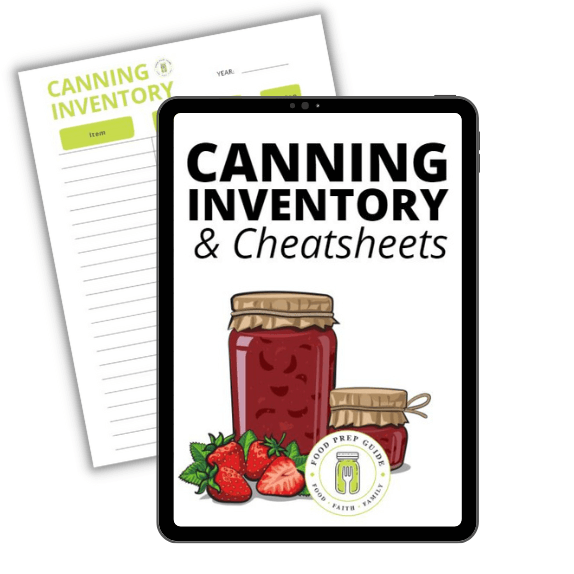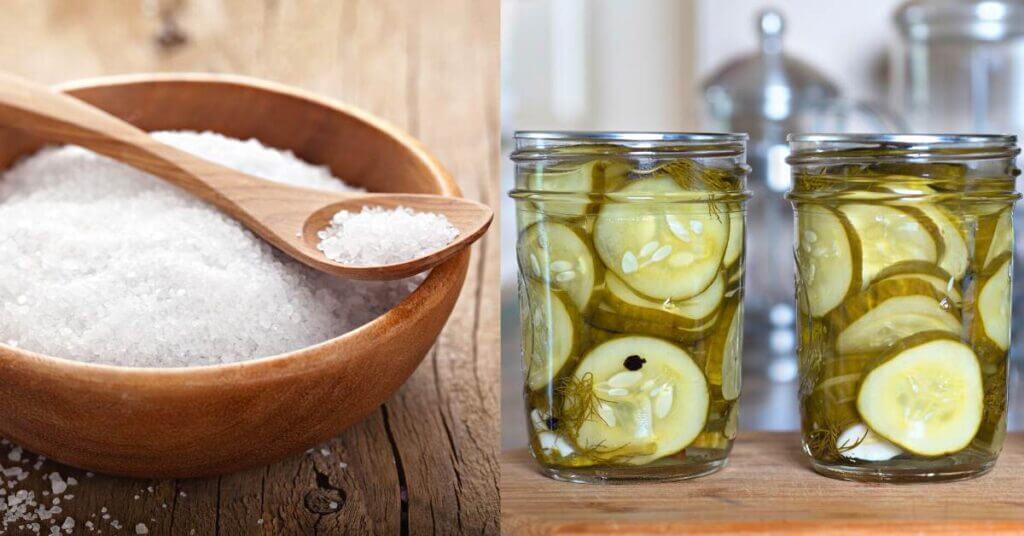Have you found a package of canning salt that’s past its expiration date? As an essential ingredient in cooking and canning, salt is worth storing long term.
If you need a short answer, canning salt doesn’t spoil unless it’s been stored improperly (more on that in a bit).
Unfortunately, the shelf life of salt is significantly impacted by its environment.
Today, we’ll share the best way to store canning salt—along with common storage solutions that you might want to avoid.
How Does Canning Salt Differ from Regular Table Salt?
Canning salt (also known as pickling salt) is non-iodized salt that hasn’t had any anti-caking agents added to it.
Prices pulled from the Amazon Product Advertising API on:
Product prices and availability are accurate as of the date/time indicated and are subject to change. Any price and availability information displayed on [relevant Amazon Site(s), as applicable] at the time of purchase will apply to the purchase of this product.
Such additives can interfere with the canning process, potentially clouding brines or altering the taste of preserved foods.
The texture of canning salt also differs from regular table salt; it has finer granules that dissolve easily and evenly in solutions, ensuring a consistent flavor throughout canned goods.
These distinctions are pivotal for food preservation. Anti-caking agents in regular salt not only compromise the clarity of a brine but also its overall quality.
Likewise, the varying granule size of salts like kosher or sea salt can lead to inaccurate measurements, risking the flavor balance in canned recipes.
It is for these reasons that canning salt, with its purity and uniformity, is the superior choice for canning.
For more detailed information, check out our guide to canning salt vs. table salt.
What Is the Average Shelf Life of Canning Salt?
Most types of salt, including canning salt, can last indefinitely. But there is a caveat.
If you want to keep a stockpile of salt in your long-term food storage pantry, you need to protect it from exposure to moisture or contaminants that compromise its pristine state.
In most cases, that’s going to be an airtight container stored in a dry place.
If you notice clumps forming or a slight discoloration, these are signs that you need to inspect your storage container more closely.
Given that it’s stored properly, canning salt has an indefinite shelf life.
Does Canning Salt Actually Expire?
Canning salt doesn’t ‘expire’ in the traditional sense. Unlike items in your pantry that might become unsafe after their sell-by date, canning salt—whether it’s pure sodium chloride or one of the other available salts like sea salt, kosher salt, or even pink Himalayan salt—remains safe indefinitely.
While canning salt lacks a definite expiration or best-by date, maintaining its purity hinges on proper storage practices. It’s more about safeguarding against quality loss, ensuring your home canning efforts yield the best possible outcomes, than actually “going bad.”
Provided salt remains in a dry place, far from moisture and in airtight containers, sealable mylar bags, or Mason jars, it retains its integrity.

Can I Still Use Expired Canning Salt for Canning?
Have you stumbled upon a container of canning salt hidden away in a dry place, wondering if it’s still good? While you don’t have to worry about canning salt expiring, it can degrade under unfavorable conditions.
If you have a container of canning salt that’s past its best-by date, you’ll want to evaluate it thoroughly before using it in home food preservation.
Start by inspecting the salt for any visible signs of contamination. Moisture exposure can lead to clumps forming, which might not be a direct indicator of spoilage but could suggest the salt has absorbed undesirable elements from its environment.
Check for any discoloration or odd smell, as these are clear indicators that the salt is no longer at its peak quality.
Should you find the salt clumped together, it’s possible to break it up and still use it in your pickle brine or other canning recipes.
Remember, the role of canning salt is to elevate the characteristic flavor of your canned goods, not necessarily to ensure their safety.
How Do You Know if Salt Is Bad?
Determining the quality of your canning salt is simpler than you may think. In fact, we’ve already discussed the primary indicators—clumps, color, and odor.
If the salt has become clumpy, it’s a clue that moisture has infiltrated the container.
Another indicator is a shift in the color of your canning salt.
Whether you’re using pure sodium chloride, kosher salt, Himalayan pink salt, or another type of salt for your canning endeavors, any noticeable color alteration signifies contamination.
This could be due to the presence of foreign substances or an alteration caused by moisture absorption.
A vibrant pink hue turning dull in Himalayan salt, for instance, spells trouble. Similarly, sea salt or kosher salt that seems visually ‘off’ in some way should raise concerns about its suitability for canning.
Lastly, check for any unusual odors emanating from the salt. While pure canning salt and most other salt products should remain odorless, the presence of a smell may indicate the growth of undesirable bacteria or contamination from external sources.
Such contamination could not only affect the taste of your pickles or the sodium content of sauerkraut but also compromise the safety of the food. It’s important to store salt in a dry place, within airtight containers, to prevent such issues.
How to Store Canning Salt to Make It Last Longer
Though we’ve mentioned each of the points below scattered throughout this article, here’s a quick list of how to store salt so you enjoy the longest shelf life possible:
- Choose an airtight container: Moisture is the arch-nemesis of canning salt. Once moisture seeps in, clumping begins. This doesn’t mean that its safety has been compromised, but it does affect quality and ease of use. Storing your salt in an airtight container or Mylar bags will keep unwanted moisture out.
- Opt for a dry place: While it might seem convenient to keep your salt near the stove or in other areas prone to dampness or steam, doing so will only hasten moisture absorption. Select a cabinet or pantry space that remains dry and cool, ensuring a long term storage solution that maintains salt at its best quality.
- Consider the type of salt: If you have ventured beyond pure sodium chloride, you’ll want to know the specific needs of your chosen salt variety. They may contain trace minerals or other elements that react differently to storage conditions. The mineral content doesn’t necessarily shorten its shelf life, but keeping them in a dry, cool environment is still paramount for maintaining quality.
- Keep it away from strong odors: Salt can absorb odors, which can affect the taste of the pickles or sauerkraut you have painstakingly prepared. Store salt away from other spices, garbage, or any area that could transfer undesirable odors to your canning salt.
- Regularly check your inventory: Periodically inspect your salt and its surrounding storage area. This will allow you to spot any potential moisture problems early and take corrective action before any degradation occurs.
Applying these simple, yet effective storage strategies will ensure your salt remains in the best condition for your home canning needs. Moisture, contaminants, and odors will no longer pose a threat, so you can focus more on preparing delicious, preserved foods rather than worrying if your canning salt has gone bad.










